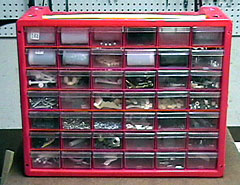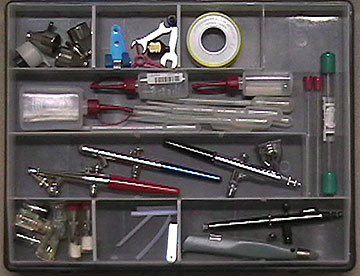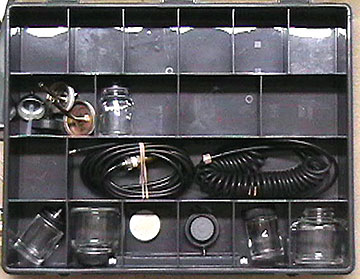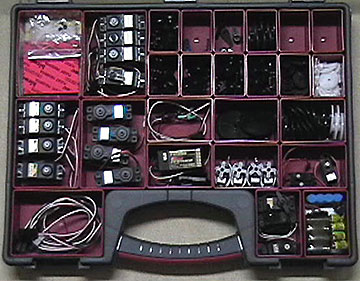|
|
Shop
Storage
Unless you have a big shop and can keep your tools set up at all times, you
will need somewhere to store things when they are not being used to free up your
work space for actually building something.
Storage can be difficult. Model builders end up with a lot of stuff.
We have a dozen kinds of tape, a half dozen knives, fifty styles of blades,
countless jars of paint, etc.
When I was in
Germany, I was building in a spare bedroom that was also being used for general
storage. It was an attic apartment, so the ceiling was sloped too (nothing
sucks like hitting your head on the ceiling three times a day... but I digress).
Needless to say, the space was a lot cramped. I decided to get my act
together and do something about it. By that I mean I wasn't getting my act
together by not acquiring stuff which is the real answer. Instead, I was buying
things to cram other things I was buying into neatly compacted spaces.
Unfortunately it is difficult to find things to store this stuff efficiently
because it is small, comes in odd sizes and there is a lot of it to segregate. It is up to us to find things that
will store our stuff in as little space as possible while still being accessible.
|
|
|
|
Shelving and Peg Boards
These are fairly basic shop items. Shelves should either be
secured or heavy enough that they will not tip over. It is also a good
idea to have some type of enclosed shelving to help keep the dust out.
Lightly colored walls reflect more light into the
room. If you mount a pegboard on the wall, buy the white kind. Be
sure to purchase plenty of pegs for the board when you buy it. You will also
need some 1" x 2" lumber to space the board from the wall so you can put the
pegs in. Just ask someone at the lumber store how to do it if you've never
hung a pegboard before.
I use a rotary tool holder that is basically a Lazy Susan type of thing
I purchased through Micro-Mark.
I mainly use it to hold the tools I use most frequently while building
plastic
models.
Although it is not as "professional" I have found heavy mugs to be
great for the same types of items. In fact, I have acquired so many mugs
over the years, that I have them all over my home. I put them on my desk
as a pencil holder, in my bathroom as a toothbrush and razor holder and in my
bedroom to toss spare change into. Usually I use my favorite mugs so at
least I am slumming with a little style. Because mugs are heavy, they do not
tip over easily.
 |
Small Rubbermaid cabinets make excellent storage.
Mine contain small bottles of paint, paint brushes, a postal scale, extra
supplies such as tapes, toothpicks — you name it. The blue drawer
cabinet to the right contains all the small
hand tools used on any given model
(jeweler's screwdrivers, propeller wrenches, etc.). I take this one
to the field with me.
On the bottom shelf is a cabinet containing
propellers,
a transmitter case, a socket set, a cordless drill and soldering
equipment. |
 |
Heavy cardboard tubes used for
rolls of printing paper are used to store sticks,
music wire,
NyRods, and
anything else long and skinny. I went to a local
blueprinter who gave me all I wanted. I just mounted a couple 1 x
2's to lay them on top of.
The top shelf is where I put my table saw and
disk sander
when they are not in use.
On the bottom shelf are heavy cardboard boxes containing
wheels and engine accessories. The large Rubbermaid container on top
has small kits in it. The one on the bottom has the remains of my
Thunder Tiger Raptor 30 helicopter.
Note the power strip mounted to a leg on the workbench.
This one was reworked to handle higher loads. It has since been
replaced with a heavy-duty power supply because rigged electricity
frightens me, frankly — particularly because I
don't know what I'm doing in that regard. |
 |
The other end of my workbench has 1/4" Masonite shelves to
hold my
balsa
wood and
plywood supplies.
When you buy a kit having a good quality box, be sure to save it.
They are hard to come by. |
 |
I picked this tool bin up in an art store for just a few dollars. It comes unassembled.
It kept falling apart whenever I picked it up which was aggravating and it was a little too tall for my
needle files making it hard to retrieve them. I
cut a portion of the supports away and used Goo to glue it all together.
The dental picks stab me when I'm not being careful. This probably isn't the best way to store them but
it's the most convenient method I have. |
 |
This is a rotary tray that I purchased from MicroMark. When I'm building plastic models
this tray has a lot more stuff in it. The tools have slowly migrated away from the tray over the past few
years but will return when I'm back to the plastic models. |
 |
A Drawer Cabinet. These are excellent for
storing small hardware. Note the film canisters that prevent the
hardware from sliding under the dividers or getting mixed together if the
cabinet tips over.
However, I purchased this cabinet in Germany. All the cabinets that I
have purchased in the U.S. had drawers that are too narrow for the film
canisters. I suggest you take a film canister with you when you go
shopping for this type of cabinet to make sure it will fit.
The white pegboard in the background makes the shop feel
larger and reflects light back into the room. |
The best general
purpose storage I have found are cabinets with clear plastic
drawers. I use one for small hardware. A second one
holds miscellaneous electronics fittings and spare air compressor parts.
No, they have no relation to one another. That is just how things fit some
times.
Unfortunately, these cabinets have their little annoyances as well. The dividers in the drawers do not stay in place
that well and sometimes they allow small items to slide between compartments.
They also lift slightly and get caught when trying to remove the
drawer.
Sometimes the drawer comes loose with a little tug immediately followed up with all the parts sailing
through the shop. Sometimes I will use plastic
cement to glue a particularly annoying divider in place but I try not to do
that any more than possible.
In a move while I was in the service all the
hardware in one of these drawer sets was mixed up. Imagine trying to separate literally
thousands of small nuts, bolts and washers. It wasn't fun.
I found
that 35 mm film canisters fit perfectly in the drawers. I asked a local
drug store to save film canisters for about a month and I kept all the
clear ones (Fuji film, if you are interested) so I can see what is inside them.
Washers do not slide under the dividers in a drawer any more and tipping it over
is no longer a catastrophe. I can also just tip over the drawer and drop
out the film canister I want rather than trying to fish a small part out of a
compartment with a tweezers.
Tackle boxes make excellent tool and storage
chests. They are made specifically to hold small lures and other tackle
used by fishermen and they work just as well for model builders. If you
have a related set of items such as
airbrush equipment, it is not a bad idea to
take it all to the store with you and find the box that gives the best fit
while allowing room for you to add more later.
 |
I used to store my airbrushes in a polypropylene
container I found in a craft store. The airbrushes are normally placed
in baggies to prevent them from clanking together.
In the upper left compartment are color cups.
To the right of that are miscellaneous tools and an airbrush hanger that
mounts to a bench. The donut-shaped item in the top middle is a roll
of Teflon tape used to seal all fittings on the air compressor and air
hoses.
The clear plastic items in the area directly
above the airbrushes are called "Pipettes." They can be found
for pennies a piece at art
stores. They are excellent for dispensing small quantities of paint
and thinner.
In the same compartment are small squeeze bottles with
stainless steel tubes. These can be found at art stores as well and
are excellent for use with oils.
In the lower left hand corner are tip assemblies
for my Aztec and Badger airbrushes.
|
 |
The upper compartment lifts out to reveal a
lower compartment where I store extra jars and hoses. Unfortunately my braided airbrush hose
does not fit anywhere in the container. |
 |
I didn't like having the airbrushes clanking around in the box shown above and found this when
perusing the sporting goods department in my local Walmart. The bait box was relatively inexpensive and
has four individual compartmented polypropylene containers.
The upper container has my airbrushes, nozzles, color cups and miscellaneous parts.
The second container has siphon caps and miscellaneous tools.
The third container has empty bottles.
The fourth container is empty.
Again, the airbrush hoses don't fit anywhere but I've yet to find anything that has compartment sizes that are
right for everything.
I could use a hot knife to remove the dividers in the unused container but every time I've done that I've been
sorry. For now I just keep hoses in a different container along with bottles that are too large to fit in
these containers. |
 |
I like this set up a lot better. |
 |
My
R/C equipment fits in a thin container I
purchased from a home improvement store in Germany. It has a clear
plastic, hinged lid. I have seen these
exact same containers recently in Home Depot and Lowes. It would be
really nice if my chargers fit in the container, but that exemplifies our
storage problems.
Anything that will hold the chargers generally
has compartments that are too large for the rest of the equipment.
It is times like this I wish I had a real wood shop and a lot more time so I
could custom make storage for all my gear.
In any case, this is far better than the shoe box I was
using. |
|
|
![]()